
Original Link: https://www.anandtech.com/show/1408
Overclocking Buyer's Guide - August 2004
by Wesley Fink on July 27, 2004 11:24 AM EST- Posted in
- Guides
Index
As we detailed in our last few Guides, the guides for High End System and Overclocking System will now come from Wesley Fink, AnandTech's Motherboard, Memory and Chipset Editor. Once the new schedule is in full swing, Wes will have a new guide for each area once a month. Evan Lieb will continue the Entry and Mid-Level Buyer's Guides. Evan will also add some new guides, with the goal of a new Buyer's Guide every week once the new guides are launched. The final Buyer's Guide additions are still in the works, so if you have a recommendation for Evan for a Buyer's Guide that you would like to see, then email your ideas to Evan.Overclocking recommendations are really quite different from High-End recommendations. We would not recommend a 2.8GHz P4 CPU for a High-End system, but it might be a natural choice for an OC guide if that 2.8 routinely reached 3.8GHz on air cooling. There are really two points to overclocking, and they are sometimes in conflict. The first goal is to squeeze the absolute best performance possible out of a given setup, and this can involve some expensive components. The second goal is to reach the highest performance possible with the cheapest part possible, which represents the best value. Sometimes you can't accomplish both of these at once, so you may see some recommendations with what, at first, appear to be strange alternates. We also can't be all things to all overclockers, so we will spell out some ground rules on the next page.
As in past Guides, we offer a recommendation for every component that goes into a computer. Our recommendation is our First Choice and we will try to explain why we chose that component. For some components, we will also offer an alternative on that type of hardware. We've added alternative hardware picks to our guides because it allows AnandTech to recommend a wider variety of hardware. This is especially true for those willing to spend a little more or to recommend a cheaper component that is of outstanding value. Alternative picks provide you other choices, which in some cases will be better suited for your needs, and in other cases, will not be.
Most of the prices listed for the hardware that we recommend can be found in our very own RealTime pricing engine. Any prices not found in our engine can be found on pricewatch. Relevant parts of our RealTime pricing engine are listed at the bottom of every page of our Buyer's Guides so that you can choose the lowest prices from a large variety of vendors.
We are always taking suggestions on how to improve our Buyer's Guides, and the changes that you are seeing here are the result of suggestions from our readers and Editors.. Considerations for future guides include a Buyer's Guide for SFF (Small Form Factor systems), Gaming System, and Laptop/DTP (Desk-Top Replacement). If you have other suggestions, let us know by emailing them to Evan; the Guides are to help you with your buying decisions.
Overclocking Ground Rules
Overclocking is a very big subject, so we really need to define where our Overclocking Guide is heading. We do not believe, at present, that AnandTech readers really want Buyer's Guides for phase-change cooling, water cooling, and other cooling techniques that change by the minute and are used in high-end overclocking. Instead, we have decided to concentrate on the best components that you can buy for overclocking on air with a decent Heat Sink/Fan (HSF). This could change in the future if other cooling techniques go mainstream, but for now, our Overclocking Guide will recommend components for an air-cooled system. Of course, if you do use water or phase-change, or other exotic cooling solutions, you could get even better performance from the components that we will recommend.While board mods are also common in high-end overclocking - to extend memory voltage in particular - we will not be recommending board mods that will void your warranty. If we know of a board mod that is commonly used, we might mention it, but that is not the purpose of the AnandTech Overclocking Buyer's Guide. We will be recommending components that you can buy, which have proven to provide significant overclocking capabilities at stock.
If you are interesting in finding out more about the extreme end, there are plenty of places on the web that cater to extreme overclockers, with widely varying degrees of success. You can go to sites like the Forum at www.xtremesystems.org and see comments from names like Macci, OPPainter or Fugger who appear routinely at the top of the charts for 3Dmark and Aquamark3. You'll find discussions of phase-change cooling and maybe even liquid nitrogen testing. The extreme high end is as much black magic as technology, and what works almost changes by the minute. We'll leave that arena to sites that already do it well.
What we would like to do well in the overclocking area at AnandTech is to recommend components from comparative testing and experience that can give you a much better than average overclocking experience without you having to become an expert with a soldering iron - or invest in a refrigerated computer case that costs more by itself than our High-End system. No one seems to be doing a good job in this area, and we want AnandTech to become a dependable resource for overclocking component recommendations.
Performance or Value
There are really two reasons to overclock. The first is to reach the absolute top performance levels possible with computer components. The second is to get superb value from your components - to make a sow's ear into a silk purse, so to speak. While this is impossible as the saying goes, in the computer arena, it is not only possible, it is pretty easy to do.Since these two overclocking areas are often at odds with each other, we could find no really good way to bridge the gap. For that reason, you will see two different recommendations for many of our choices - performance and value. You can expect our Performance selection to reach the highest overclocking levels that you can reach. The Value choice will give you incredible overclocking performance for the money - bang for the buck.
Some components lend themselves to overclocking better than others. Processors, Motherboards, Video Cards, and Memory are targets for most overclockers. So, we've concentrated our efforts on these components. While Hard Drives are not normally modified to perform better, they do have an impact on final system performance and, perhaps more important for the overclocker, they can sometimes limit or enhance the ability of a system to overclock. For those reasons, we will also be recommending Hard Drives in this Overclocking Buyer's Guide. The Case/Power Supply can also influence overclocking results as a result of more efficient cooling from the case or stable, high-output power from the power supply, so these components are also included.
The rest of the system components like Monitors, Optical Storage, and Input Devices are not so easily overclocked, and we will not devote attention to these components in our Overclocking Guide. Since overclocking can run the gamut from value systems to high-end, it is also almost impossible to second-guess what an overclocker might be looking for in a monitor, optical storage, sound card, speakers, LAN, keyboard and mouse. We suggest that you refer to other AnandTech Buyer's Guides for more information on our recommendations for those components.
In the end, we will summarize the recommendations in the Overclockers Buyer's Guides in four areas - Overclocking Performance, OC Performance Alternate, Overclocking Value, and OC Value Alternate. You will see quite a spread between these four systems, but they all represent the best of overclocking - from top overclocking performance on one end to the best overclocking performance that we could find for the money you would spend at the other end of the spectrum.
CPU and Motherboard: PERFORMANCE OC Recommendations
CPU: AMD Athlon 64 FX53 (2.4GHz 1024K L2 cache)Motherboard: MSI K8N Neo2 (nForce3 Ultra)
Price: CPU - $811 shipped (Retail). Motherboard - $165 shipped
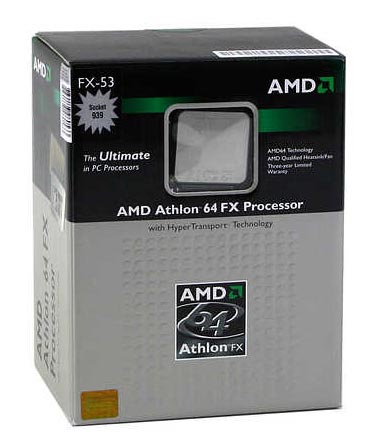
For Overclockers looking for the best performance possible, it would be tough to recommend anything other than the Athlon 64 FX53. The Athlon 64 is currently the fastest processor you can buy; the Dual-Channel Socket 939 is the top-performing A64 Socket, and the FX is the fastest 939 processor. The FX also has the distinction of being the only processor that is completely unlocked. That means that you can adjust multipliers both up and down, to obtain the highest possible speed at the fastest DDR400 memory timings, or to obtain the highest FSB that your high speed memory can run or your CPU can reach. Most FX53 that we have tested easily reach 2.6GHz at default voltage with air cooling, and some do even better. This pegs performance at a clock speed that we won't see in a retail CPU until late this year.
While the 3500+ (2.2GHz) can reach similar speeds, it is still multiplier locked at the top (lower multipliers can be selected though) and the cache is only half of what is found on FX53. The 3800+ runs at the same 2.4GHz with half the cache, but again, the regular Athlon 64 are top-locked, and the small price difference between FX53 and 3800+ makes it difficult to choose the 3800+ over the FX53.
What you get in the FX53 is the fastest stock performance currently available among desktop processors, and the ability to reach even higher. AMD does not call the FX series their Enthusiast CPU for nothing. There are no locks to hold you back and the real limit is what the .13 process can do with Athlon 64. Based on how very well the FX53 has performed in our tests in recent reviews, we can hardly wait to test the new 90nm process FX chips that should become available at the end of the year.
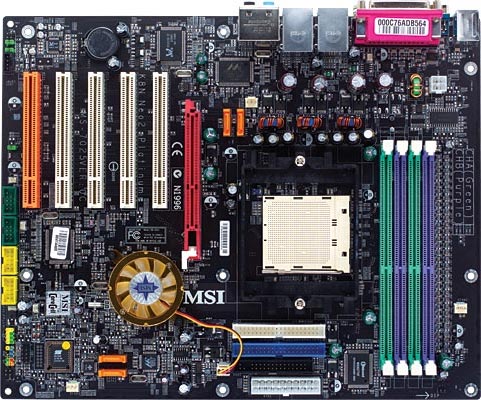
While they are just beginning to appear in the retail channel, the MSI K8N Neo2 stood out in our recent Socket 939 roundup as a top performer and earned the AnandTech Gold Editor's Choice. Perhaps even more important to an overclocker, the K8N Neo2 was the only board in the 939 roundup to match and actually edge ahead of the standout memory performance of the legendary Asus P4C800-E in our overclock tests. The K8N Neo2 actually reached a Clock Frequency of 290 (DDR580) with fast DDR550 memory that we used in our overclock tests. Wherever you can take the FX53, the K8N Neo2 will go - to the limits of your CPU or memory.
While the overclocker will likely turn off most everything when pushing boards to the limit, when the day is done and the system returns to a little more sedate levels, the K8N Neo2 will continue to impress with a full implementation of the features of the nForce3-250Gb/Ultra including fast on-chip LAN, any-drive RAID that allows IDE and SATA hard drives to be combined in RAID arrays, and an on-chip Firewall. The feature set compares well to any premium Socket 939 on the market and will not disappoint.
For the best overclocking experience, you can count on a working AGP/PCI lock with adjustments from 66 to 100, CPU multipliers from 4X to 20X, HyperTransport adjustments from 1GHz to 200MHz (5x-1x), and CPU frequencies from 200 - 300. You also get a full range of voltage adjustments - vCore to 1.85V, memory voltage to 2.85V, and vAGP to 1.85V. This is even a board for the beginning overclocker, since there are automatic overclocking selections in Core Cell that set everything for you. You just choose the % overclock from 1% to 11% and the board does the rest.
We have never tested a perfect board, and as much as we like the K8N Neo2, there are still areas for improvement. The CPU frequency range is really not wide enough for a board that does 290 at 1:1; we would prefer to see 350+ in that area. The greatest improvement that MSI could make is to provide finer adjustments for CPU ratios, providing 0.5X ratios like some of the competing boards. Last, there is no real voltage adjustment for HT or chipset voltage, and that would add to the flexibility. In the end, it's hard to complain about a board that does so much, so well. The MSI reached 290x9 (2610) with fast memory, and for those who prefer raising the ratio, 2652 was an easy 13x204. Since all of these were at near stock voltages, serious overclockers will find ways to get even more from an FX53 on the MSI K8N neo2.
Listed below is part of our RealTime pricing engine, which lists the lowest prices available on AMD CPUs from many different reputable vendors:
If you cannot find the lowest prices on the products that we've recommended on this page, it's because we don't list some of them in our RealTime pricing engine. Until we do, we suggest that you do an independent search online at the various vendors' web sites. Just pick and choose where you want to buy your products by looking for a vendor located under the "Vendor" heading.
CPU and Motherboard: PERFORMANCE OC Alternatives
CPU: Intel Pentium 4 540 (3.2Ghz)Motherboard: Asus P5AD2 Premium (Intel 925X)
Price: CPU - $288 shipped (Retail with HSF). Motherboard - $279 shipped
It was difficult to decide between the Single-Channel Socket 754 Athlon 64 and the new Intel Socket 775 for the Performance Overclocking alternative. Despite the massive increase in memory bandwidth that comes with the Dual-Channel 939, the fact remains that the Athlon 64 is not particularly bandwidth-starved compared to recent deep-pipe Intel designs. As you can see in the launch article on Socket 939, this translates into performance of the single-channel 754 Athlon 64 that is only 2% to 9% slower than the new 939 at the same speed. In real terms, this means that a Socket 754 combined with a second-generation Socket 754 motherboard having AGP/PCI locks is still outperforming Intel's latest and greatest Pentium 4 560 (3.6GHz). The new pricing of the 2.4GHz 3700+ at about $525 also makes this tempting for the Performance overclocker. This is still a very good alternative, but in the end, the new Socket 775 on one of the motherboards that solves the Intel OC lock riddle won out as the OC alternative for features and future.
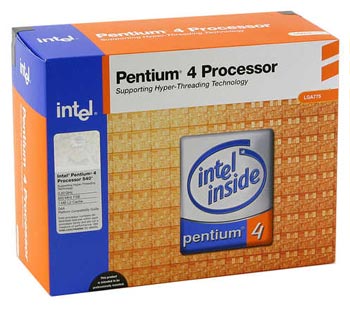
Intel produces processors with locked multipliers, so there is no real advantage for an overclocker to choose a top Intel chip other than the higher stock speed. Since most Socket 775 processors that we have tested tend to top out in the 3.8GHz to 4.0GHz range with modest voltage increases, the task of choosing a 775 CPU is one of balancing ultimate overclock with board Clock frequency capabilities. In this case, the Asus P5AD2 tops out at 278 with ATI PCIe video or about 260 with nVidia PCIe. We also showed, in our DDR2 memory roundup, that all current DDR2 memory could run at DDR2 667, which is achieved at a Clock frequency of 250. If, for margin, we choose 250 as our clock goal, we need a CPU with a multiplier of 16 to reach 4.0Ghz. This makes the 3.2E Socket 775 an ideal match to a Performance overclocking system.
If you need to save a bit of money, the 3.0E or 2.8E 775 is also a great choice for overclocking. Keep in mind that a 14 multiplier will require an unreachable 285 for 4.0GHz, making the 3.0E a better choice of the two for performance overclocking. If you could reach a CPU clock of 285, then the memory becomes an issue since DDR2 becomes "if-y" above DDR2 700. At 285 the DDR2 memory speed at stock 4:3 ratio is DDR2 760.
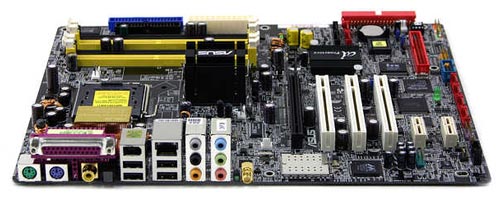
When Socket 775 was launched a few weeks ago, it did not appear that any of the new 925X/915 motherboards would ever become a recommended Overclockers board. The 925x/915 boards appeared limited to about a 10% overclock by design. However, several manufacturers found effective ways around the overclocking issues, and the 925X boards began to open up.
The best overclocker that we have seen so far among the 925X motherboards is the Asus P5AD2 Premium, which has already shown the ability to reach 278 FSB with the difficult combination of a top-end ATI X800 XT PCIe video card and a SATA hard drive. The P5AD2 was designed from the start to be a dream board for Performance overclocking. It is the only board that we have tested with a DDR2 memory option of 600MHz at stock speed in addition to the common 533 and 400 options. Asus also provides a full range of AI overclock options for the more timid, with auto presets from 5% to 30% overclock, which represent a range of auto overclocks to FSB1066/DDR2-710.
Serious overclockers will want to dial their own, and the Asus offers a full range of both familiar and new manual settings. PCI Express can be adjusted from 90 to 133, but we have found that the best performance is with Auto, which adjusts PCI dynamically at boot for best overclock. There are also adjustments to fix or float the PCI clock. CPU frequency is adjustable from 100 to 400, CPU voltages can be tweaked from default (1.3875V) to 1.7000V in very fine .0125V increments, and memory voltage is adjustable from 1.8V to 2.1V. There are even very useful adjustments for Chipset Core voltage and FSB Termination voltage.
While we could wish a wider range of Memory voltage adjustments, the Asus P5AD2 delivers on overclocking when many other 925X boards struggle with PCIe and SATA overclocking issues. The P5AD2 is an expensive motherboard, but it will take 775 overclocking to places that are difficult to reach with other 925X motherboards.
Listed below is part of our RealTime pricing engine, which lists the lowest prices available on Intel CPUs from many different reputable vendors:
If you cannot find the lowest prices on the products that we've recommended on this page, it's because we don't list some of them in our RealTime pricing engine. Until we do, we suggest that you do an independent search online at the various vendors' web sites. Just pick and choose where you want to buy your products by looking for a vendor located under the "Vendor" heading.
CPU and Motherboard: VALUE OC Recommendations
CPU: Intel Pentium 4 2.8C 800MHz FSB Northwood (512K L2 cache)Motherboard: ASUS P4C800-E Deluxe (875P chipset)
Price: CPU - $175 shipped (Retail). Motherboard - $172 shipped
Choosing an Intel processor these days can be very confusing, as there are so many flavors available. Because the Intel processors are multiplier locked, we like the 2.8 speed for overclocking. The 14 multiplier is realistic for reaching the best overclocks that you will likely achieve with a Pentium 4. The question becomes, "which 2.8?" The 2.8A is based on the Prescott core, but is without Hyperthreading and runs with a 21 multiplier at a 533 FSB. While we have seen reports of these CPUs reaching 180 to 190 overclocks (3.78GHz to 4.0GHz), we are still left with the diminishing returns of a high multiplier, a FSB below 800, and no Hyperthreading. If the 2.8A were cheaper than the 2.8E or C, we could easily recommend it, but at about the same price, we would choose an 800FSB 2.8.
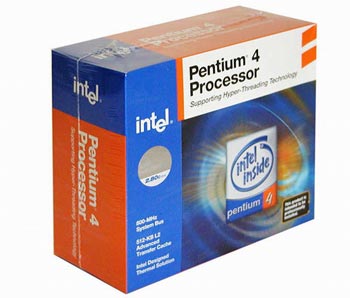
With the Prescott 2.8E at the same price as the Northwood 2.8C, the 2.8C is an easy choice unless you have to have the highest FSB for bragging rights. On Socket 478, Northwood performs better than Prescott, and you will also likely find that the overclocked Northwood, which will top out about 3.4 to 3.7GHz, is still a better performer than the overclocked Prescott on the 875 chipset and Socket 478. The 2.8C runs at 800MHz FSB with a 14X multiplier. This multiplier should allow you to squeeze everything from the Northwood Pentium 4 that you can get. 3.7GHz would require a doable 265 Clock frequency, and the more likely 3.5GHz can be achieved at 250FSB, which is DDR500 at 1:1 memory.
It's been several months since we did some serious overclocking with a Northwood chip, but reports are that recent Northwoods are overclocking very well. Our Evan Lieb reached 3.4GHz with default 1.525 voltage, with a 2.8C on a P4C800-E motherboard. With voltage cranked to 1.65V, he reached a very stable 3.59GHz, which proved its stability by running 8 hours+ looping Prime95 and SPECviewperf 7.1.1 programs. Chips and performance do vary and overclocking is never guaranteed, but the performance that we have seen with off-the-shelf 2.8C processors suggest that you can and should be able to reach the highest levels of Northwood performance with a 2.8C and a motherboard that overclocks very well.
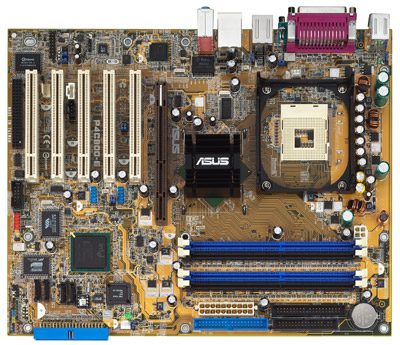
When all is said and done, the P4C800-E Deluxe has proven itself to be the premier Pentium 4 motherboard for overclockers. This motherboard has reached 290+ in our DDR memory test bed, and we have seen 270MHz-280MHz FSB using just basic retail Intel cooling with a good 2.4C processor. With a 2.8C processor, you should be able to run fast memory at 1:1 to the fastest processor speed that you can reach. You also have the option of running fast DDR400 memory at 2-2-2 timings, at a lower ratio, which is often just as fast as higher memory speeds at higher latencies. With all things being equal, higher memory speed is faster, but higher memory speed often requires higher latencies. Which is better depends on how aggressive your timings can be at the highest memory speed.
However you cut it, though, the ASUS P4C800-E Deluxe offers everything an overclocker could want: plenty of room for FSB overclocking, 2.85V max VDIMM, 1.95V max Vcore, and features like CSA Gigabit LAN, SATA and IDE RAID, IEEE 1394 FireWire, etc. This motherboard is absolutely packed with just about every feature that a high end user and overclocker could need.
Listed below is part of our RealTime pricing engine, which lists the lowest prices available on Intel motherboards from many different reputable vendors:
If you cannot find the lowest prices on the products that we've recommended on this page, it's because we don't list some of them in our RealTime pricing engine. Until we do, we suggest that you do an independent search online at the various vendors' web sites. Just pick and choose where you want to buy your products by looking for a vendor located under the "Vendor" heading.
CPU and Motherboard: VALUE OC Alternatives
CPU: AMD Athlon XP 2500+ Mobile Barton (512K L2 cache)Motherboard: DFI Infinity NFII Ultra (nForce2 Ultra 400)
Price: CPU - $88 shipped (OEM). Motherboard - $91 shipped. HSF - $12 shipped
There is a lot to be said for the overclocking value of an Athlon 64 2800+ or 3000+ combined with a 2nd Generation 754 board, like a MSI K8N Neo or Abit KV8 PRO. We have used these combinations with outstanding results. However, it is still hard to beat the value of an Athlon XP on a flexible nForce2 motherboard for bang-for-the-buck.
Of the 4 recommendations for Overclocking system, the Athlon XP is the poorest ultimate performer, but there is no denying the incredible value that the Athlon XP platform delivers. You will also find the ultimate performance level of the overclocked Athlon XP will not be much lower than the Intel Pentium 4 system, and the total cost for motherboard and CPU is a little less than either the Intel CPU or the Asus motherboard. You can't find value better than this.

The current darling of the Athlon XP overclockers remains the Barton mobile chips. Operating at 1.45V instead of 1.65V, and with other electrical layout changes, the mobile 2500+, for example, consumes only 45 watts at stock speed and has that much more voltage headroom. The fact that it is factory unlocked, unlike the regular 2500+, also makes the mobil XP chips that much more attractive for overclocking. The mobile 2500+ multiplier is adjustable from the stock 14X up to 22X+, and downward as low as 5X, depending on the motherboard. This is vitally important to overclockers because this allows them to squeeze more performance from their chip without having to resort to problem FSB speeds.
The unlocked speeds and multipliers allow great flexibility with the 2500+ mobile. While the 2500+ is rated at 133 FSB CPU with a multiplier of 14 (the Desktop 2500+ is 166x11), most overclockers have no problem reaching the 11x200 speed of the top-of-the-XP-line 3200+. In fact most 2500+ reach even higher, many to 2.4GHz and beyond, which are performance levels much higher than any Athlon XP curretnly available. The 2600+ mobile looks even more promising as an overclocker, with a 133MHz higher speed at 1.45V, though we have not yet tested the 2600+. With specifications of the same 45 watt power consumption and a 15x133 FSB, it is hard not to be tempted when it is less than $10 more than a 2500+.
On a DFI motherboard, we have reached over 2.5GHz with a 2500+ at just 1.7V, which is close to the normal voltage for a regular 2500+. Other Editor's have typically found stable performance around 2.4GHz at 1.65V, which is faster than the fastest 2.2GHz of the stock 3200+ Athlon XP, and even better performance at higher voltages.
When you over-volt your CPU, you should normally be careful of how much you do. 1.65V to 1.7V should not be an issue with an Athlon XP mobile, and even 1.80V should not dramatically reduce CPU life. However, over-volts of 1.85V and above will likely reduce the life of your CPU, with the risk of a very quick death. This is not as big an issue with a CPU that costs $88, but what is pocket change for some is a lot of money for others, so be cautious and smart. The higher the voltage, the higher the heat, and the more cooling that is needed.
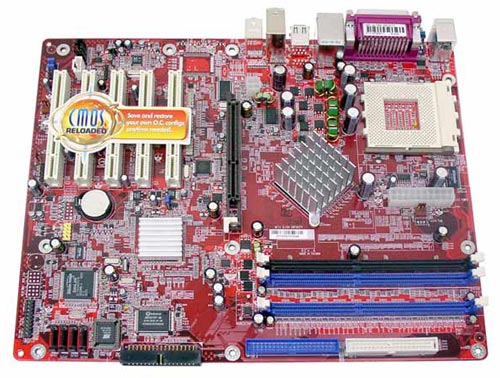
If you check Forums devoted to overclocking, you will find the DFI NFII LANParty has become almost a legend in the Athlon XP overclocking community. It is the only nForce2 Ultra 400 motherboard that we have seen to reach a FSB of 280 under any set of conditions, and we also see many end-users who reach 250FSB with this board. The full-blown NFII LANParty also comes with everything but the kitchen sink at a cost of around $140, which makes it a bit pricey for a value OC system, unless you happen to need or want the UV slots and LAN cable, FrontX, and a PC Transport carrier. However, many don't realize that the same outstanding board is available without all the pretty stuff and accessories, as the NFII Ultra Infinity.
None of the overclocking options are missing from the Infinity - they are just as fantastic as those found on the LANParty - and at around $90, it is hard to beat the value of the Infinity NFII board. You will find CPU Frequency adjustments to 300, and AGP can be fixed at any setting between 66 and 100. Memory voltage extends from 2.5V to a truly outstanding 3.3V to accommodate even the fussiest high-speed DDR. CPU voltages extend to 2.0V, chipset to 1.9V, and AGP from 1.5V to 1.8V. These ranges are simply outstanding and frankly, a bit dangerous with air, but they should make even water and phase-change overclockers happy.
The NFII Ultra Infinity even has the MCP-T southbridge for those who care about the excellent Sound Storm audio provided by that southbridge. DFI even provides the CMOS reloaded feature from the LANParty boards that allows several different BIOS setups to be saved - a very handy feature for overclocking. Overclockers will also be happy to find the 4 mounting holes around the CPU socket for heavy-duty cooling; although, we do find the CPU area has too many components around the socket that could interfere with some of the larger cooling solutions. In the end though, at a price of around $90, most everyone will find reason to be very happy with the nForce2 Ultra 400 DFI as the base for a Value overclocking system.
Listed below is part of our RealTime pricing engine, which lists the lowest prices available on the AMD nVidia motherboards from many different reputable vendors:
If you cannot find the lowest prices on the products that we've recommended on this page, it's because we don't list some of them in our RealTime pricing engine. Until we do, we suggest that you do an independent search online at the various vendors' web sites. Just pick and choose where you want to buy your products by looking for a vendor located under the "Vendor" heading.
DDR Memory
DDR Recommendation: 1GB Kit (2 X 512MB) OCZ PC3700 EBPrice: $340 shipped
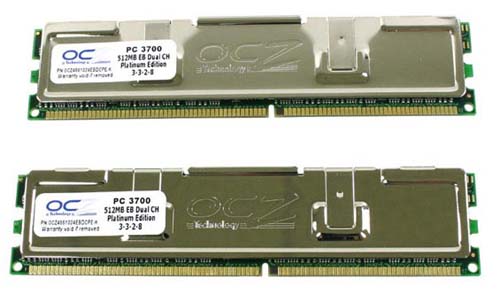
One of the advantages of the new AMD Socket 939 is that it uses regular unbuffered dual-channel memory. This means almost any memory will fit your new Socket 939 system. However, we have found that some memory perform much better in Athlon 64 systems than others, and the overall best Athlon 64 performance that we have found was with OCZ 3700EB, or Extended Bandwidth, memory.
The EB takes a little different approach to memory timings, and runs at 2.5-2-2, at DDR 400. This is still competitive with the best memory available, but by DDR433 to DDR450, the EB becomes the fastest memory that we have tested at that speed. Performance extends well beyond DDR500 and the performance at DR500 is the best that we have tested. Many Athlon 64 boards are picky about memory, but every Athlon 64 board that we have tested so far seems quite content with either 3700EB or 3500EB memory.
In the past year, OCZ has raised their Customer Service standards to among the best in the memory industry. We often get emails reporting very positive Customer Service and quick problem resolution when customers have contacted OCZ directly. OCZ combines that excellent Customer Service with a Lifetime Warranty.
DDR Alternative: 1GB Kit (2 X 512MB) Corsair 3200XL or 3200XL PRO
Price: $300 or $330 shipped
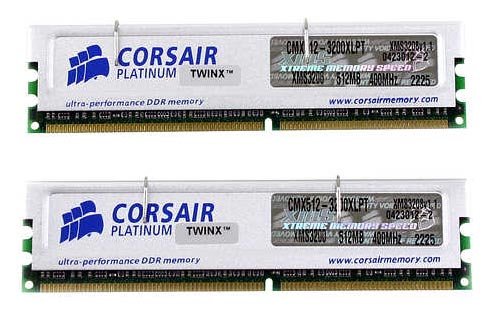
Corsair 3200XL roared on the scene in May with a return of 2-2-2 timings to DDR400. These fast timings were thought to be dead after Winbond discontinued their BH5 memory, but Corsair managed to return 2-2-2 to the market with a new generation of Samsung memory chips. The Corsair is an outstanding match to the alternate DFI 875B LANParty motherboard, and will provide the fastest DDR400 memory performance that you can currently find.
Corsair 3200XL also extends performance all the way to DDR500, so you will have incredible headroom when you select this memory for your system. The Corsair memory also works well on the AMD Athlon 64 platform when we tested it, but performance did not extend quite as far on the AMD platform. It is still a good choice for Athlon 64 machines where extremely high overclocking is not a top concern. While 2-2-2 memory based on Samsung chips is now available from OCZ, Kingston, and Mushkin; Corsair pioneered the return to 2-2-2 and was the first on the market with new memory capable of 2-2-2 timings.
Corsair is the standard by which every Enthusiast Memory manufacturer is measured, and their Customer Service is among the best in any industry. Corsair also provides a Lifetime Warranty on memory products and their "RAM Guy" is a well-known resource for memory problems in many Forums.
Either of these DDR recommendations will work very well on the MSI K8N Neo2, Asus P4C800-E Deluxe, or DFI NFII Ultra Infinity. However, DDR2 memory is required for the Asus P5AD2 Premium.
Listed below is part of our RealTime pricing engine, which lists the lowest prices available on DDR memory from many different reputable vendors:
If you cannot find the lowest prices on the products that we've recommended on this page, it's because we don't list some of them in our RealTime pricing engine. Until we do, we suggest that you do an independent search online at the various vendors' web sites. Just pick and choose where you want to buy your products by looking for a vendor located under the "Vendor" heading.
DDR2 Memory
DDR2 Recommendation: 1GB Kit (2 X 512MB) Crucial PC2-4200UPrice: $364 shipped
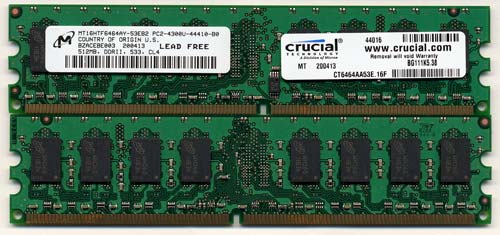
In our recent roundup of DDR2 memory, the Gold Editors Choice went to Crucial DDR2 533. The 533-rated Crucial is based on the top-performing Micron DDR2 chips and it performed at 533 at 3-3-3 timings, which is much better than the rated 4-4-4 timings. We even reached the highest speed that our memory test bed could support at DDR2-686 - well beyond the next speed step of DDR2-667. Even 686 was achieved at 4-4-4 timings, which are, again, better than the Jedec rating of 5-5-5 at DDR2-667.
Crucial accomplishes all this performance with one of the better prices among DDR2 memory. This is not to say that Crucial DDR2-533 is cheap, but DDR2 has dropped quite a bit in price the last month. In fact, the current price is not radically different from the better high-speed DDR that we have recommended.
Frankly, all the memory in our DDR2 roundup reached DDR2-667 speed, so you can shop for DDR2 looking for the best value right now. However, the DIMMs based on Micron memory - from Corsair, Crucial, OCZ, Kingmax, and Mushkin - provided the widest bandwidth in our DDR2 tests. You can select any of them and expect excellent DDR2 performance.
We are currently looking at DDR2-667 rated memory from Corsair, Crucial, and OCZ. These DIMMs may provide even more headroom at the very top of DDR2 performance, but it is too early to say. We will be doing an update in the next few weeks on exactly what you can expect with DDR2-667 rated modules now that we have the Asus P5AD2, which is capable of extending DDR2 memory to its limits.
Listed below is part of our RealTime pricing engine, which lists the lowest prices available on DDR2 memory from many different reputable vendors:
If you cannot find the lowest prices on the products that we've recommended on this page, it's because we don't list some of them in our RealTime pricing engine. Until we do, we suggest that you do an independent search online at the various vendors' web sites. Just pick and choose where you want to buy your products by looking for a vendor located under the "Vendor" heading.
AGP Video
AGP Overclocking Recommendation: eVGA 256MB GeForce 6800 GTPrice: $389 shipped
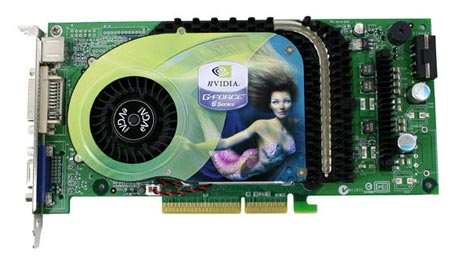
While the dust is still settling in this round of the video wars, we do know that the new generation of video cards from nVidia and ATI are twice as fast as the previous generation in many benchmarks. We also found in our testing of the new nVidia nForce3-250 chipset that it performs a bit better with an nVidia graphics card. With that in mind, we included a GeForce 6800 GT in our Overclocking system to match the nForce3-250 Ultra-based MSI K8N Neo2.
Why a GT instead of a 6800 Ultra? The 6800 GT is unique in also sporting 16 pipelines just like the 6800 Ultra. In fact, the only real difference that we can find between the 6800 GT and the more expensive 6800 Ultra is the clock speed. The two 6800 GT that we tested both reached 6800 Ultra clock speeds pretty handily, so if you want 6800 Ultra performance, you may well get it with a 6800 GT overclocked to 6800 ultra speeds. You can also buy 6800 GT cards, which is more than we can say for 6800 Ultras, which are very difficult to find.
The 6800 GT is clocked at 350MHz with memory at 1.0Ghz; the 6800 Ultra clocks the GPU at 400MHz, and the memory at 1.1GHz. Both have 256MB of DDR3 memory and 16 pipelines. The easiest way to try your hand at overclocking a 6800 GT to Ultra levels is with a widely available utility called Coolbits, which adds Clock Frequencies to the advanced tab of the nVidia properties. Coolbits even offers a Test and Optimal Settings button so you can check to see if your 6800 GT can support 400HMHz and 1.1GHz speeds or possibly even higher speeds.
If budget is a concern for your overclocking system, there is also a 12-pipe 6800 available for about $300. The 6800 is sill a decent performer and even easier to find, but it is not likely that you will push a 6800 to 6800 Ultra performance levels, and you are still stuck with 12 pipelines instead of the 16 available with the 6800 GT and 6800 Ultra. There is also an even faster version of the 6800 family, called the 6800 Ultra Extreme, but as rare as 6800 Ultra cards are right now, we would hesitate to recommend an even more rare card, which is just a higher-clocked 6800 Ultra. Perhaps a 6800 Ultra, when you can find one, will overclock to Extreme levels.
The best way to see what the 6800 Ultra can do is to read the latest AnandTech Video Card review, which compares ATI X800 and nVidia 6800 in both AGP and PCI Express flavors.
The AGP Overclocking Recommendations will work very well on the MSI K8N Neo2, Asus P4C800-E Deluxe, or DFI NFII Ultra Infinity. However, a PCI Express Video Card is required for the Socket 775 Asus P5AD2 Premium.
Listed below is part of our RealTime pricing engine, which lists the lowest prices available on nVidia video cards from many different reputable vendors:
If you cannot find the lowest prices on the products that we've recommended on this page, it's because we don't list some of them in our RealTime pricing engine. Until we do, we suggest that you do an independent search online at the various vendors' web sites. Just pick and choose where you want to buy your products by looking for a vendor located under the "Vendor" heading.
PCI Express Video
PCIe Overclocking Recommendation: ATI X800 XT Platinum 256MBPrice: N/A
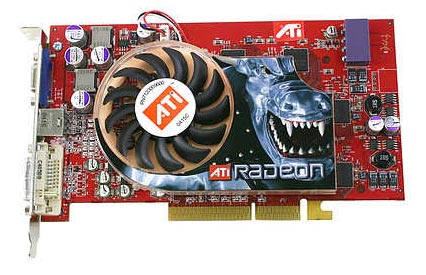
It's almost an embarrassment to recommend a video card that we couldn't find for sale anywhere, but if you are an overclocker looking for top performance on a new Intel 925X board, the X800 XT is the best option for the present. If you're set on a new Intel 775 system for overclocking, then you need to get in line to buy this card.
Unfortunately, the ATI X800 PRO is 12 pipelines instead of 16, so more than just overclocking the video card is required to reach X800 XT performance levels. Many are reporting success in modifying certain brands of the X800 PRO AGP to 16 pipelines, but explaining how to do that is beyond the scope of this Guide. A search should find "how-to" information if this interests you. However, we have not seen any reports of modding a PCIe X800 PRO to 16 pipes. In addition, we could not even find an X800 PRO PCIe for sale at any vendor either.
There are X600 XT PCIe cards available from several vendors and they would be a good alternative if your overclocking goal is to reach the highest speed possible with a 775 platform. We are finding the ATI PCIe cards to be more tolerant of out-of-spec PCIe settings on the 775, so the X600 XT should allow you to reach the highest overclocks possible in the new PCIe systems. However, you need the X800 XT if your goal is the highest overclocks combined with top video performance at those rarified overclocks above 250 to 260 clock frequency.
As we have pointed out in the past, you can choose either the X800 XT or the 6800 Ultra and be perfectly happy and perfectly competitive in the performance area, but for overclocking PCI Express, we have found the ATI cards simply survive to higher PCIe overclock levels.
Listed below is part of our RealTime pricing engine, which lists the lowest prices available on ATI video cards from many different reputable vendors:
If you cannot find the lowest prices on the products that we've recommended on this page, it's because we don't list some of them in our RealTime pricing engine. Until we do, we suggest that you do an independent search online at the various vendors' web sites. Just pick and choose where you want to buy your products by looking for a vendor located under the "Vendor" heading.
SATA Hard Drive
SATA Recommendation: Dual Western Digital Raptor 74GB 10,000RPM SATAPrice: $386 shipped
As Anand found in his first review with the new storage benchmarking system, there is Western Digital Raptor and there is everything else. It is hard to argue with the choice of the top Raptor drives in a system geared to get the most possible from your computer.
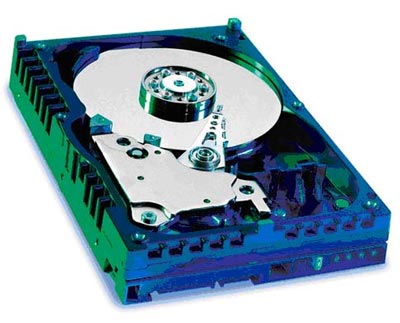
The problem with the top Raptor drives is that they are still relatively small as hard drives go, so we are recommending two drives in a RAID 0, RAID 1, JBOD, or just plain 2-drive setup. Anand has shown there is little performance advantage to RAID 0, but striping is still useful for improving boot times. It can also improve performance in multi-tasking situations, which are admittedly rare on the desktop. RAID 1, on the other hand, is useful in protecting against hard drive failure, which is always a risk when pushing a system to its limits with overclocking. Frankly, many overclockers keep a second hard drive with known good images to restore hard drives that end up in data corruption in overclocking attempts, which is another great use for the second Raptor hard drive.
The storage capacity for two 74GB WD Raptor drives is a generous, but rational, 148GB of fast access storage. Compared to SCSI solutions with similar performance, the 2 Raptors are a virtual bargain. The 74GB Raptors have double the storage of the legendary 36.7GB Raptors, an increase in speed, and the same 8MB buffer. We are also pleased to see a price drop in the 74GB Raptors of almost $50 for the pair in the past two months.
The 5-year warranty for the Raptor drives makes this investment in high-speed storage a little easier to handle. All Drives will fail at some point because they have moving parts, but you have warranty reassurance for 5 years that attest to the quality of these WD Raptor hard drives. Previously, 10,000RPM speeds or a 5-year warranty were features only found on enterprise/SCSI drives, but they have now reached our high-end system desktop.
All of the Overclocking recommended and alternative motherboards, even the DFI Socket A board, have built-in capabilities for SATA or SATA RAID, so it is relatively easy to enjoy this level of performance on any of the four recommended and alternate motherboards.
For overclockers, there is, however, a flip side to using SATA drives. Many motherboards that are favorites with overclockers do not overclock as high with SATA drives as they do with IDE. This primarily applies to Intel chipsets that integrate SATA in the chipset and virtually require a fixed 33.3 PCI bus for SATA drives. At high overclocks, the SATA lock often seems to get compromised and slight drift means no SATA hard drive. You should keep this in mind with some other motherboards, but the two Intel Asus boards recommended in this overclocking guide seem more immune than most boards to high FSB SATA failure.
Listed below is part of our RealTime pricing engine, which lists the lowest prices available on SATA storage from many different reputable vendors:
If you cannot find the lowest prices on the products that we've recommended on this page, it's because we don't list some of them in our RealTime pricing engine. Until we do, we suggest that you do an independent search online at the various vendors' web sites. Just pick and choose where you want to buy your products by looking for a vendor located under the "Vendor" heading.
IDE Hard Drive
IDE Recommendation: Seagate ST3200822A (200GB) Baracuda 7200RPM (8MB cache)Price: $119 shipped
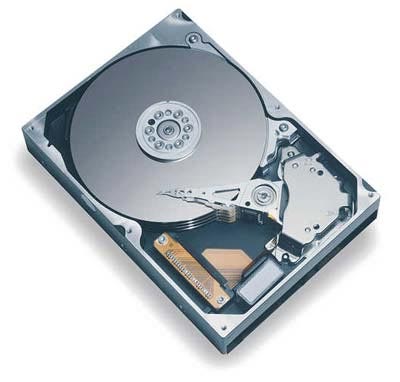
While IDE drives, including our alternate Seagate Barracuda 200GB, are not as fast as the Western Digital Raptor 10,000RPM SATA drives, they are still preferred by many overclockers because they generally have fewer problems when overclocking with IDE drives. IDE drives are also much cheaper than WD Raptors, so there is less to cry about if you destroy a hard drive in overclocking.
The Seagate 200GB is a particularly good buy, offering the same 8MB cache as the Raptor drives and very large 200GB storage capacity for a small $120 price. While the well-known Seagate drives offer impressive specifications, the most important feature of the Seagate 200GB is not something you can see. With hard drive manufacturers reducing warranties to one year, the Seagate 200GB now carries a 5-year manufacturer's warranty. That is not a typo, as a check at Seagate's website shows that Seagate just increased the warranty for ALL internal hard drives to 5 years. With this Seagate delivering hard drive capacities at 60 cents per Gigabyte, this drive also delivers excellent value.
If you prefer a SATA solution, there are excellent choices with a SATA interface instead of IDE. However, we see no real reason to recommend a SATA drive over IDE for an overclocking system unless there are features like the Raptor Speed, NCQ or warranty that make the SATA a better performer. There is also no reason not to choose SATA if you prefer the narrow cables, but please keep in mind that SATA drives can sometimes be roadblocks to great overclocking. Overclockers also connect and disconnect drives frequently, and SATA connectors are still very fragile and more easily breakable than the admittedly bulky, but durable, IDE connector.
Listed below is part of our RealTime pricing engine, which lists the lowest prices available on IDE storage from many different reputable vendors:
If you cannot find the lowest prices on the products that we've recommended on this page, it's because we don't list some of them in our RealTime pricing engine. Until we do, we suggest that you do an independent search online at the various vendors' web sites. Just pick and choose where you want to buy your products by looking for a vendor located under the "Vendor" heading.
Case and Power Supply
Computer Case
Recommendation: Coolermaster CM Stacker (STC-T01)Price: $175 shipped
Overclockers tend to swap components at a dizzying rate, always looking for something that will run just a little faster or perform a little higher on a competitive benchmark. Since components are likely to be swapped a lot, a case should be as flexible as possible, providing for future components as well as those you might use today. Cooling is also a huge concern for overclockers, so a case that provides exceptional cooling is also a plus.
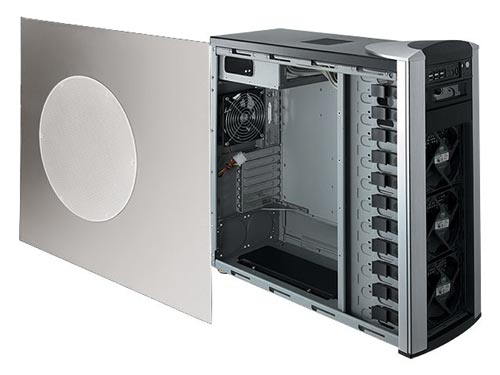
The 1.0 mm Steel Plate and Aluminum alloy Coolermaster CM Stacker is a case that fits the bill for the overclocker. Not only does it support 11 5-1/4" devices, it also supports both standard ATX and coming BTX designs. The case comes with conversion instructions for mounting a BTX motherboard. You also get support for either one or two standard ATX power supplies, and up to 8 internal fans, in addition to a unique optional crossflow fan.
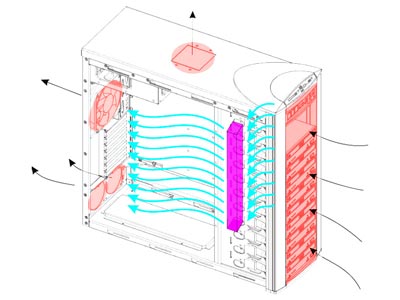
Coolermaster cases are still some of the best for build-quality that you will find anywhere, and the CM Stacker is the most flexible case design that we have even seen. Whatever your particular desires in overclocking your system, you are likely to find a way to do what you need to to do with the CM Stacker.
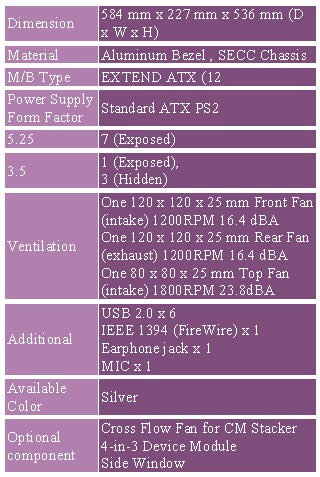
You have to see the flexibility of the CM Stacker to believe it.
Power Supply
Recommendation: OCZ Power Stream 520WPrice: $150 shipped
The first thing that most overclockers learn is that the power supply does matter, because the first wall most overclockers run into is the inadequate power supply that came with their white-box computer. Overclocking demands much more of a computer system than running the system at stock speeds. If you think a Prescott at 3.4Ghz demands wattage, then you quickly realize a Prescott at 4.0Ghz demands even more power. The same is true of video cards. If a 6800 Ultra Extreme demands a decent 470W power supply, then you will need even more power when you overclock that 6800 Ultra to higher GPU and memory speeds.
You also quickly learn that all power supplies are not created equal. Most power supply ratings are combined ratings, as regular readers have learned in Power Supply reviews at AnandTech. This means that as some of the power supply rails are driven, other rails drop in power, and may end up supplying less than ideal power under stress. The very best power supplies individually control the power rails. They, therefore, usually handle the stress of overclocking much better than a PS with a combined rating. These are the power supplies that are most coveted by overclockers.
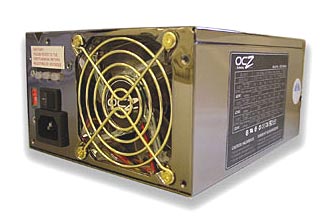
A superb example of a power supply geared to overclockers is the new OCZ Power Stream 520. It was designed from the ground up for overclockers, and features individual rails that are even tweakable for higher output or exact values. There are even LEDs on the rear of the black chrome case that tell you if the PS is operating in spec, under spec, or over spec. These same LEDs can even be used to tweak individual rails for optimum power.
520W sounds like a lot of power and it is, but truthfully, this power supply would probably be rated at 700 watts by a manufacturer who was trying to impress with specs. The 520W rating is conservative and this PS can easily handle almost anything an overclocker wants to throw at it. While the OCZ Power Stream are new to the market, they have quickly become favorites of the extreme overclocking community.
You will also find a stock 24-pin ATX power connector that will work with the new Socket 775 motherboards and servers, as well as a 24-pin to 20-pin adapter to use with motherboards requiring a standard 20-pin connector. There are also extra long SATA and 4-pin Molex connectors to power anything you might put in a full tower case or the CM stacker, as well as special heavy duty cables for the demands of hard drives and the latest high-end video cards. You can find out more about the Power Stream power supplies at the Power Stream product page.
Alternative: Antec True Power 480W
Price: $87 shipped
If $150 for a top power supply seems a bit rich for your budget, there is a very good alternative with the Antec True Power 480. The True Power series features individually powered rails, unlike the lesser Antec power supplies, which brings excellent stability to power-hungry overclocking.
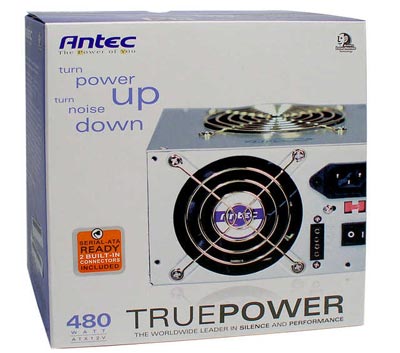
The True Power series, in particular, is one of the most trusted power supplies among enthusiasts, and it will provide your overclocked system with stable power and some reserve for overclocking. While a good quality 350W or 400W power supply might do the job for processors and video cards at stock speeds, you will definitely need a high-quality power supply like the True Power 480 if you plan to overclock.
If you cannot find the lowest prices on the products that we've recommended on this page, it's because we don't list some of them in our RealTime pricing engine. Until we do, we suggest that you do an independent search online at the various vendors' web sites. Just pick and choose where you want to buy your products by looking for a vendor located under the "Vendor" heading.
Overclocking System Summaries
PERFORMANCE OC Recommended
Our Recommended System for Performance Overclocking should allow you to reach the highest performance levels possible with standard air cooling. The components represent those components that have provided the best overclocking experience in our testing at AnandTech. Those who have thought about building a Socket 939 for Performance overclocking will absolutely love this setup.| AMD Socket 939 Athlon 64 FX53 | ||
| Hardware | Component | Price |
| CPU & Cooling | AMD Athlon 64 FX53 Socket 939 Retail | $811 |
| Motherboard | MSI K8N Neo2 (nForce3 Ultra) Socket 939 | $165 |
| Memory | 1GB (2 X 512MB) OCZ PC3700 EB | $340 |
| Video Card | 256MB eVGA 6800 GT | $389 |
| Computer Case Power Supply |
Coolermaster CM Stacker plus 520W OCZ Power Stream PSU |
$325 |
| Hard Drive | 2x74GB Western Digital 74GB Raptor 10,000RPM SATA RAID (148MB Total) | $386 |
| Bottom Line | $2416* | |
Please keep in mind that the $2416 is an overclocking system core price, and does not include all the components that you will need for a full-blown system.
PERFORMANCE OC Alternative
The Performance Overclocking Alternative assembles the best overclocking components for a top-end Intel 925X socket 775 system.| Intel Socket 775 Pentium 4 540 | ||
| Hardware | Component | Price |
| CPU & Cooling | Intel Pentium 4 540 (3.2GHz) | $288 |
| Motherboard | Asus P5AD2 Premium | $279 |
| Memory | 1GB (2 X 512MB) Crucial PC2-4200U | $364 |
| Video Card | 256MB ATI X800 XT | $550 (EST) |
| Computer Case Power Supply |
Coolermaster CM Stacker plus 520W OCZ Power Stream PSU |
$325 |
| Hard Drive | 2x74GB Western Digital 74GB Raptor 10,000RPM SATA RAID (148MB Total) | $386 |
| Bottom Line | $2192* | |
While $2192 is not exactly cheap for a top Socket 775 system, we have saved quite a bit of money by choosing a great overclocking motherboard in the Asus P5AD2 Premium and pairing it with a 3.2E that is capable of high overclocks with this board. The system also includes an estimated price for the ATI X800 XT, which has been shown to handle the out-of-spec PCIe speeds that we are seeing on all of the 925X/915P motherboards, which have been found to support higher overclocking speeds.
VALUE OC Recommended
Our readers who are already overclockers will most likely have systems that resemble either of our Value Overclocking Systems. Both are proven overclocking performers based on Pentium 4 Northwood and Athlon XP processors that have a solid history of stand-out overclocking performance. You will get outstanding value for your dollar with either Value OC system, and your system will be capable of performing at the top levels of Northwood and Athlon XP performance.| Pentium 4 Socket 478 | ||
| Hardware | Component | Price |
| CPU & Cooling | Pentium 4 2.8C Northwood (Socket 478) | $175 |
| Motherboard | Asus P4C800-E Deluxe | $172 |
| Memory | 1GB (2 X 512MB) OCZ PC3700 EB | $340 |
| Video Card | 256MB eVGA 6800 GT | $389 |
| Computer Case Power Supply |
Coolermaster CM Stacker plus 480W Antec True Power PSU |
$262 |
| Hard Drive | Seagate 200GB 7200RPM IDE (8Mb Cache) |
$119 |
| Bottom Line | $1457* ($1157) | |
The Socket 478 Value OC system weighs in at $1457 for the core components. The Coolermaster CM Stacker may be overkill for some Value overclockers, and you can easily cut $100 of the total ticket with a cheaper Aluminum Case, like a Kingwin. Another place to cut costs would be substituting an ATI 9800 Pro video card at $200 less than the nVidia 6800 GT. These 2 changes alone drop the cost to $1157.
VALUE OC Alternative
Some readers will still consider the Athlon XP Value OC system the king of overclocking, but since its performance would be last in this group, you really should take a look at some of the other overclocking alternatives presented here. There is no doubt, however, that an Athlon XP mobile on a great nForce2 ultra 400 motherboard provides incredible bang-for-the-buck.| AMD Athlon XP and nVidia nForce2 400 Ultra | ||
| Hardware | Component | Price |
| CPU & Cooling | AMD Athlon XP Barton 2500T Mobile $88 Heatsink/Fan $12 |
$100 |
| Motherboard | DFI NFII Ultra Infinity | $91 |
| Memory | 1GB (2 X 512MB) Corsair 3200XL | $300 |
| Video Card | 256MB eVGA 6800 GT | $389 |
| Computer Case Power Supply |
Coolermaster CM Stacker plus 480W Antec True Power PSU |
$262 |
| Hard Drive | Seagate 200GB 7200RPM IDE (8Mb Cache) |
$119 |
| Bottom Line | $1261* ($836) | |
If the final tab of $1261 for the core components of an XP mobile system seems high, three areas stand out for paring. First, go with a cheaper case for $100 less. Second, buy an ATI 9800 PRO for $200 less and overclock the heck out of it. Third, go for one of the CAS 2.5 value DDR400 memories from Corsair, Geil, OCZ, Kingston, and others; this could save you about $125. These three substitutions reduce the price by $425 and get the core system price down to $836.
Final Words
If you have any interest in overclocking, there should be something that will interest you in our Recommendations and Alternatives. With a range of prices from $836 to just over $2400 for core overclocking components, you should find what you are looking for. It was not really our intention to do four Buyer's Guides in looking at overclocking, but it was hard to address what we believe Overclockers are looking for without addressing both the Performance and Value segments of overclocking.This led to recommendations for a Athlon 64 Socket 939 system, a Prescott Socket 775 system, a Northwood Socket 478 system, and a Athlon XP Socket A system. With this range of choices, you will surely find an overclocking system that will meet your needs.
Experienced overclockers will not need this caution, but we strongly recommend that beginning overclockers consult our forums for more information on how to overclock, as it can be dangerous for inexperienced users. What we've talked about in this guide may be new to you, if you don't have some type of background in overclocking. If you don't understand what we have discussed in this Overclocking Buyer's Guide, please go to AnandTech's forums (or any good online hardware forum) for advice and answers to your basic overclocking questions. You should also be aware that most manufacturers discourage overclocking, and the overclocking of components will often void your warranty.
We did not really address Heatsink/Fans in this Overclocking Buyer's Guide because we figured 10,000 words was more than enough for the first revision. In all cases, we assumed the retail HSF in our prices or a modest choice for HSF. We do intend to address HSF recommendations in next month's update to the Overclocking Guide.
Now, go build your dream overclocking system and let us know what you think in our comments section at the bottom of every page. Whether you agree or disagree with where the Overclocking Buyer's Guide is going, we would like to know what you think.







